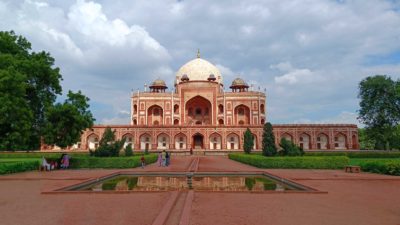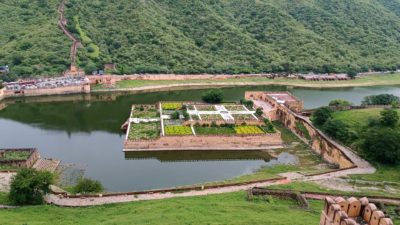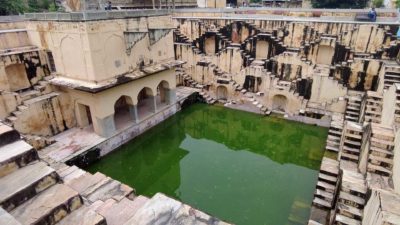The golden triangle of India with Varanasi
North India Trip – 10 Days
If you are planning to visit India for the first time, there is no better option than this golden triangle with the add of the most ancient spiritual city in the world, Varanasi… This special itinerary, comprising the three famous cities of India-Delhi, Agra and Jaipur, is designed to offer the main tourist attractions and the best responsible tourism projects of Northern India. It is the perfect choice for your first trip to India, because it brings together the best experiences of Northern India in a 10 days tour. The itinerary will overwhelm you with all the Indian wonders: the grand and fascinating architectures, the deep religious sense, the human and cultural variety. The amazing magic of an Indian adventure is condensed into a very introspective journey, from which many people return changed. The journey will begin in Delhi, the capital: here you will have the chance to visit the heart of the old city, the ancient district of Paharganj, with an exceptional tourist guide from a local NGO that helps street kids, taking care of their education, job training and access to health services. Next stop will Jaipur, knonwn as the pink city, the largest city in Rajasthan, and the city of Agra with the famous Taj Mahal.
From here on, it’s a whirlwind of unparalleled emotions and scents: the town of Khajuraho, the symbol of Indian tantric erotism. Soft, sensual, elegant, and provocative all at once: the erotic sculptures of the Khajuraho temples in India inspire wonder and curiosity. Strolling through the beautiful garden surrounding the temples and pausing to admire their sculptures is like witnessing “live” the ancient Indian treatises on love and sex, such as the renowned *Kamasutra*. From the architectural jewel of Khajuraho, we will move on to the city of Varanasi, on the banks of the Ganges, which is considered the abode of the god Shiva. It is also one of the Shakti Peethas (places of worship of the goddess Shakti) and hosts one of the twelve Jyotirlinga (shrines in honor of Shiva) of India, making it one of the fundamental pilgrimage sites for Hindus. The city also has a great historical meaning, with its over 3000 years. The silk produced here is famous all over the world, as gold and silver threads are inserted inside the complex interweaving of the fabric: an inevitable purchase for shoppers and at the same time an asset of great artistic value. The tour of North India at this point ends by returning to Delhi for the international flight.
SIGN UP FOR THE TRIP
Registration can be requested for group travel or for self-travel. For group travel, registration is not binding. Upon reaching the minimum number of members necessary for the formation of the group, usually 4 or 6 people, you will be asked for confirmation of booking and payment of a deposit.
JOURNEY OVERVIEW AND PROGRAM DETAILS
1° DAY: VISIT TO DELHI
Delhi
Arrival at Delhi airport. Transfer to hotel for some rest. Around 10 am after breakfast you
will start your guided tour of Old Delhi. In particular, you will visit the Red Fort (visit only from outside), a UNESCO World Heritage since 2007, built in 1639 by Mughal Emperor Shah Jahan (the creator of the Taj Mahal), the the Jama Masjid, one of the largest mosques in India, where an ancient copy of the holy Quran written on Deer skin is preserved. Visit small lanes of this part of the city such as Chawri Bazar, one of the busiest street of Old Delhi. Later visit Raj Ghat, the site of Mahatma Ghandi cremation. After lunch you will visit new Delhi with its Government buildings such as the India Gate, an arch erected in memory of the Indian soldiers who lost their lives fighting for the British Army during World War I, and the Parliament House. In the late afternoon we will continue the visit with the Gurudwara Bangla Sahib, one of the most prominent Sikh gurdwara, or Sikh house of worship in India, known as the “Sarovar.” Then trasfer to the hotel. Overnight in Delhi (D)
2° DAY: TRANSFER TO JAIPUR
Delhi – Jaipur
Around 10 a.m. will start the visit of the poor district of Paharganj, in Old Delhi, led by special tour guide from a local NGO, which saves street kids, giving them education and job training. This experience aims to show the tragic reality of street kids, watching the world from their perspective. A former street kid will walk you trought the streets of the district of Paharganj and the areas around the train station. This gives you the unique opportunity to visit the city with exceptional guides. Later, transfer by car to Jaipur (about 4 and a half hours), the largest city in Rajasthan and symbol of magnificence and abundance. The city was founded in 1727 by Jai Singh II and it was the first Indian city with a reticular planimetry. Jaipur was the capital under the reign of the Kachwaha clan and it is an ideal tourist destination. Overnight in Jaipur (B).
3° DAY: VISIT TO JAIPUR
Jaipur
After breakfast, visit to the Hawa Mahal along the road to Amber Fort. Transport by jeep to the castle. After lunch, visit to the Anokhi museum, which shows how important craftsmanship is for the rural economy of India. In the afternoon, visit to the Royal Palace and the ancient city; places full of charm, culture and architecture, with splendid fortresses, majestic palaces, peaceful temples and beautiful Havelis (ancient noble residences). The “Pink City” can boasts of a refined craftsmanship and a spectacular goldsmith tradition, which enhance its uniqueness. Lush gardens and flower beds add serenity to the landscape. All together these ingredients create a picturesque environment that fascinates every visitor. Walking throught the streets of this unique city makes it easier to understand local history and culture. Overnight in Jaipur. (B)
4° DAY: TRANSFER TO AGRA
Jaipur – Agra
After breakfast transfer to Agra by highway (about 4 hours). Arrival in Agra and lunch in a small restaurant supported by a local NGO that helps women victims of acid attacks. After lunch visit old Agra. You wll explore the old city on a 3-hour walking tour led by a local guide who shows you daily life away from the typical tourist attractions. Learn about Agra’s history, architecture, and traditions as you discover the old market and its surroundings. The first stop will be the Jama Masjid, a big mosque opposite to Agra Fort. You will continue walking along the narrow lanes of old Agra, meeting a local family living in the area. Later you will visit the ancient Manka Meshwar temple (Shiva temple), followed by the wholesale spice market, Rawatpara, where you can find Agra petha, a candy made from ash gourd. You will also experience the bustle at the shoe mandi in Johri Bazar, the only street of Ayurvedic doctors, the paan (betel leaf), and the food street of Seth Gali. At sunset Visit to the Taj Mahal (closed on friday). It is one of the most famous and visited monuments of India, built at the behest of the Mughal emperor Shahjahan in memory of his beloved wife Mumtaz Mahal. The majestic white marble building is now a universal symbol of love and romance and it is also one of the seven wonders of the world. It was built in 1653 (symbolically remembered in the 16 gardens and 53 fountains) and it took 16 years of work and the commitment of thousands of artisans
Overnight in Agra (B, L)
5° DAY: TRANSFER TO KHAJURAHO
Agra- Khajurahoo
Early morning transfer to the railway station and departure by the high-speed train Vande Bharat (departure at 06:00 AM) to Khajuraho (approximately 7 hours). Arrival in the early afternoon (1:00 PM) and check-in at the hotel. In the afternoon, we will visit the ancient city of Khajuraho, where a local guide will explain the caste system, showing the different areas inhabited by Brahmins, Kshatriyas, Vaishyas, and Shudras.
Overnight in Khajuraho (B)
6° DAY: TOUR OF KHAJURAHO
Khajuraho
In the morning, visit the extraordinary temple complex built between the 10th and 11th centuries, famous for its erotic sculptures and designated a UNESCO World Heritage Site. We will explore the temples in the Eastern group, known for their intricate details, the Southern group, and then the Hindu temples in the Western group. In the afternoon, free time will be available to stroll around the town.
Overnight in Khajuraho (B)
7° DAY: TOUR OF VARANASI
Khajuraho – Varanasi
After breakfast, transfer to the airport for a flight to Varanasi. Upon arrival, check-in at the hotel and take a guided tour of the sacred city, with its numerous attractions and ancient temples, such as Kashi Vishwanath, Kal Bhairava, Durga Kund, and Annapoorna. Varanasi is also an important artistic, cultural, and handicraft center. Visit the main ghats of Benares, the steps leading to the Ganges River, many of which are used for ritual ablutions, while others are dedicated to cremations. Many ghats are associated with legends or mythological episodes, while others are private. The most important cremation site is Manikarnika Ghat, known as Mahasmasana, included in the tour. It is believed that burning bodies at these special places is the correct way to attain Moksha, or salvation. In the evening, you will attend the famous Ganga Aarti Puja ritual, which takes place daily at sunset at Dasaswamedh Ghat, near the Kashi Vishwanath temple. This highly choreographed ceremony is performed on a stage by a group of young pandits, dressed in saffron robes, holding ceremonial plates in front of them.
Overnight in Varanasi (B)
8° DAY: THE SPIRITUALITY OF VARANASI
Varanasi
Early in the morning, witness the Aarti Puja ceremony at Assi Ghat. Following this, you will have the opportunity to join yoga lessons alongside pilgrims who attended the prayer. Before sunrise, enjoy a boat excursion on the Ganges River (approximately 2 hours) to admire the rising sun and the city awakening amidst rituals, ablutions, prayers, and chants. Return to the hotel for breakfast. Varanasi is known as Mahashamstana, the great cremation ground; here, death is celebrated in the same way as life. During this guided visit, we will explore the main places to experience how death is perceived in Hindu culture. We will visit a Mukti Bhawan, a “hotel” where people with only a few days left to live stay. People from all over India come here because it is believed that those who die in Varanasi are liberated from the cycle of reincarnations and achieve moksha (liberation). Next, we will visit Manikarnika Ghat, one of the most significant cremation sites, where we will observe funeral rituals. The tour will conclude with a visit to one of the most important temples dedicated to Shiva Mahadev in his form as Maha Mrityunjay, which means “defeating death.” Inside the temple, there is an ancient well whose water is believed to cure any illness.
Overnight in Varanasi (B)
9° DAY: VISIT TO SARNATH
Varanasi
After breakfast, spend time discovering the ghats (steps) that line the Ganges River. In the afternoon, visit the Buddhist city of Sarnath, located 13 km northeast of Varanasi, near the confluence of the Gomati and Ganges rivers in Uttar Pradesh. Sarnath Deer Park is the place where Gautama Buddha first taught the Dharma. Today, it is one of the four key pilgrimage sites for the Buddhist community (along with Bodhgaya, Kushinagar, and Lumbini in Nepal) and attracts believers from around the world, especially on Purnima (Buddha’s birthday), a day that celebrates Buddha’s life, death, and enlightenment.
Overnight in Varanasi (B)
10° DAY: RETURN HOME
Varanasi – Delhi
In the morning, transfer to the airport for a domestic flight to Delhi, followed by an international departure flight.
ACTIVITIES
- Explore Old Delhi through the eyes of young guides trained by a local NGO
- Discover the famous monuments and architectural masterpieces of Delhi
- Experience the Pink City of Jaipur, the capital of Rajasthan
- Visit the iconic Taj Mahal, one of the most famous buildings in the world
- Stroll through the beautiful gardens surrounding the erotic temples of Khajuraho and admire their sculptures
- Visit historical and archaeological sites
- Discover the spirituality and Hindu temples of Varanasi
- Explore the sacred city of Varanasi
- Visit the Buddhist city of Sarnath
SOCIAL AND ENVIRONMENTAL IMPACT
The whole itinerary has been designed to promote direct or indirect benefits for local communities, environmental conservation and protection of cultural heritages. When possible we have selected traditional accommodations sensible to social and environmental issues, following general principles and practices of responsible tourism. North India is full of contradictions, here extreme richness and poverty coexist. On the one hand magnificent Havelis and ancient buildings transformed into luxury hotels, and on the other people who have nothing. The selection of accommodation facilities is very important and cannot disregard respect for traditional local architecture; in this way the monetary flow deriving from tourism contributes to the protection of historic buildings. The economic impact of tourism makes it possible to renovate and preserve some of the palaces, fortresses and historic residences, which otherwise would be abandoned or destroyed; with a responsible tourism tour, local communities and NGOs can also benefit from it. This tour combines famous tourist destinations and lesser-known places in order to distribute in a fairer way the economic flow produced. Moreover, staying in traditional places rich in history, allows you to fully immerse yourself in the culture of the place, making it possible to create an authentic encounter with the local communities. Local NGOs and voluntary associations will show tourists the reality of their country, through their daily activities. The NGO you will meet in Delhi supports street kids, recovering them from the street and turning them into tourist guides; poor and exploited children are a huge issue of the indian capital and hearing about their personal experiences, about the alternative life they have managed to build thanks to the NGO, will help the visitors to understand this particular aspect of indian society. They will show you the reception centers and the projects undertaken by the organization, which for years has been providing assistance, education and professional training to these children. In Agra there will be a visit to a fair-trade cafe that supports women victims of acid attacks and a responsible tour that explains the history of the Taj Mahal. Often hotels and restaurants exhibit artists from the region, but without creating real contact with the artist himself. During our tour, instead, it will be possible to visit their homes; in this way the tourist will have the opportunity to better understand their art and their culture, while the artist will not have to compromise, retaining his decision-making power. Our contribution to these communities ensures the maintenance and strengthening of their autonomy; the possibility to improve their skills and create a network of artists covering all of Rajasthan, in order to expand the benefits drawn from Responsible Tourism. We organize workshops to learn not only their traditional crafts, but also to better understand their social context. We also propose a Responsible Shopping, buying products directly from artisans, without any intermediary making profits, often unreasonable, at the expense of producers. Likewise, we encourage home-stays, so that the economic benefits go directly to the communities.
TIPS BEFORE DEPARTURE
It is advised to follow a conduct which respects local culture to avoid any hassles or unwanted troubles along your journey. In particular, avoid displays of affection (such as hugging, kissing etc) in public places, as this behaviour is not appreciated by local people. Some tribal community, especially old villagers, are particularly sensitive to photographs. It is always better to ask permission before taking any picture in villages or local markets.
It is recommended to follow a dress code while travelling in India for two main reasons: the first one is to avoid hurting local people; the second one is to protect yourself from the unstable weather conditions. One more thing to keep in mind is the mosquito problem, keeping your arms and legs covered will provide more protection (however, don’t forget to bring with you mosquito repellents). Furthermore, temples, churches, synagogues, monasteries and mosques are places of worship and visitors are required to wear appropriate clothing. Access may be prohibited to men and women wearing skirts or shorts and sleeveless shirts.
Another useful advise is to get onto India’s time zone even before your arrival; trying to eat and sleep according to local time. If you arrive in India early in the morning, trying to stay awake will help the body’s internal clock reset.
A conscious approach to travel requires a considerable capacity and willingness to adapt and adjust to the local environment and culture. If you wish to travel with us we request you to be open enough to experience local culture, religion and traditions without bias and pre-conceived ideas you might have before the departure and which belong to our Western cultural way of thinking. Exploring with fresh eyes, with patience and openness, you will be able to access the real essence of North India cultural heritage through the places and people you are going to meet; if you are ready to do this effort you will really enjoy the beauty of a completely different cultural tradition, the extraordinary of the nature, the solemnity of temples and palaces, the holiness of the waters of countless rivers and oceans that flow through this magic land.
HOTELS
We selected beautiful and traditional heritages resorts with excellent facilities throughout the tour. All the hotels have been selected carefully according to criteria of social and environmental impacts.
TRANSPORT
Private cars or minibuses will be used depending on the number of participants. A high-speed Vande Bharat train between Agra and Khajuraho and a domestic flight to Varanasi are included in the program.
WHEN TO GO
The best time to visit northern India (Uttar Pradesh, Madhya Pradesh and West Bengal) is from October to March. Rajasthan instead has a dry climate all year round, with sporadic monsoon storms between July and August, usually intense and short. Maximum temperatures ( between 26° and 36° degrees Celsius) are recorded betweem October and March. Monsoons occur mainly from May to September.




